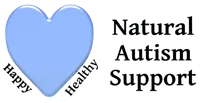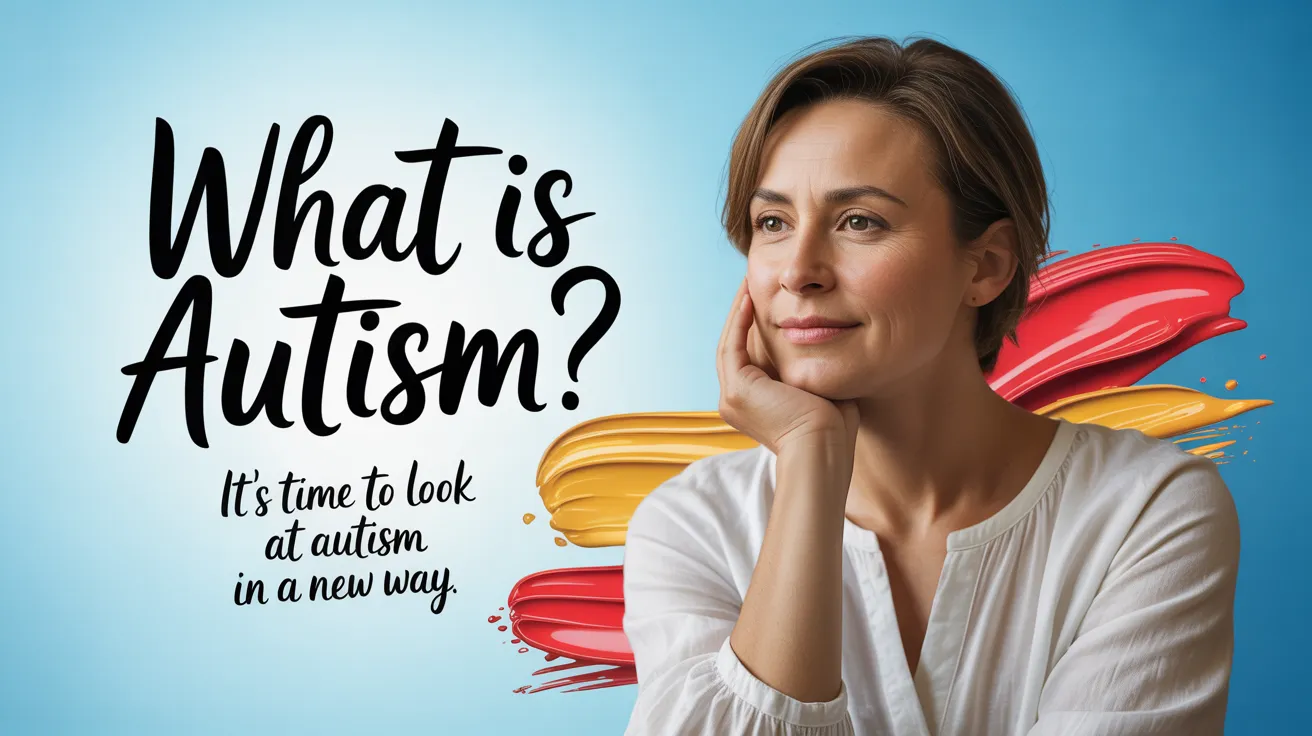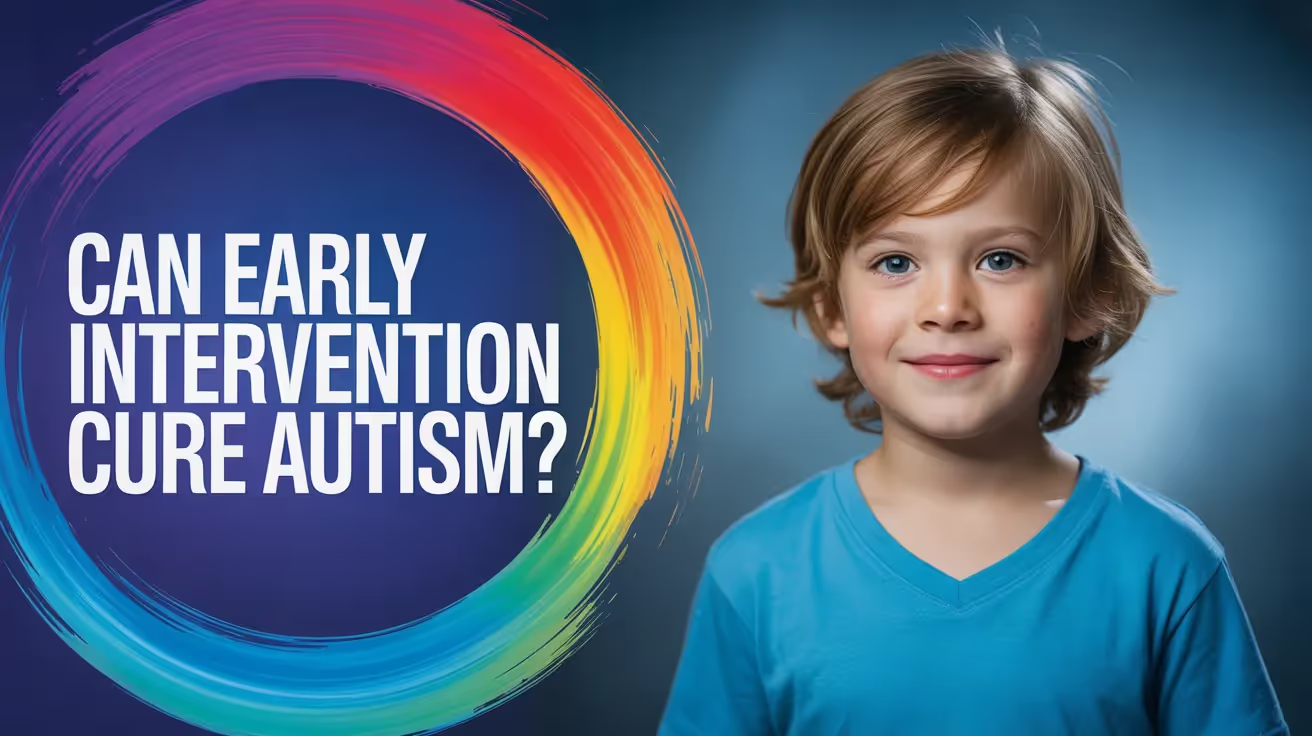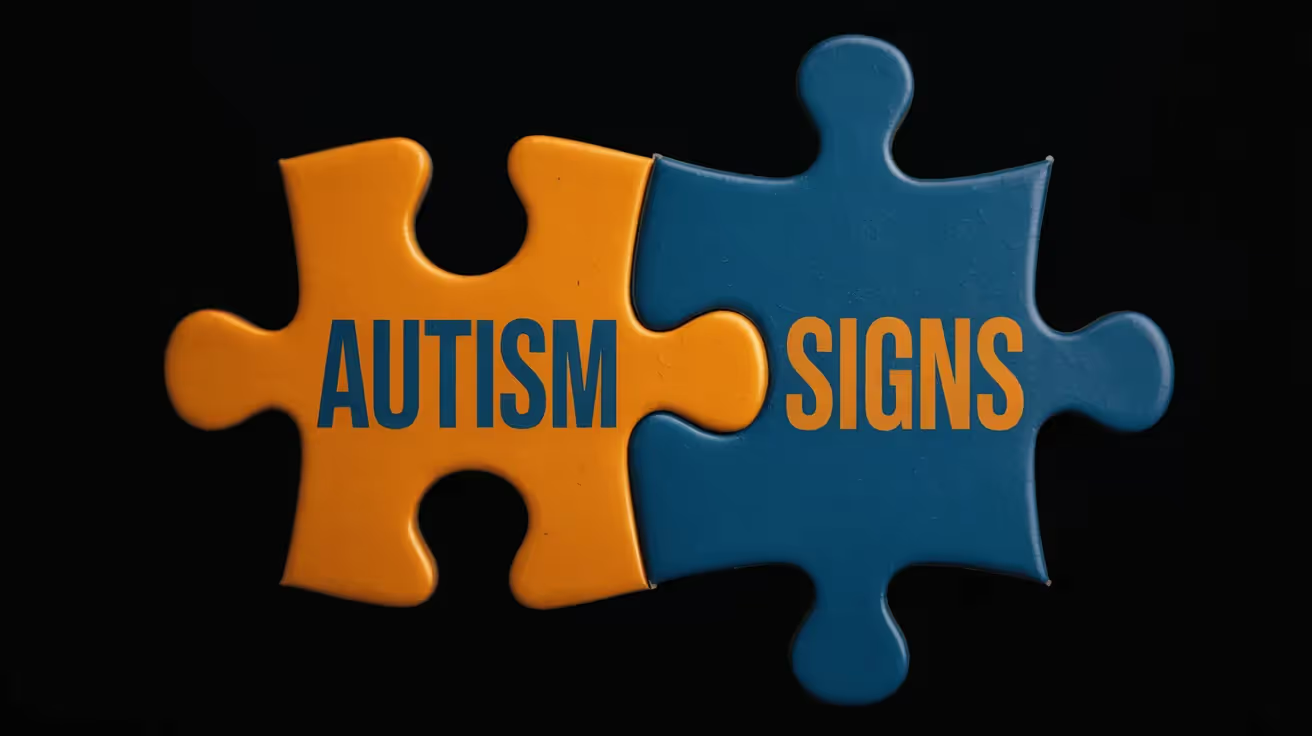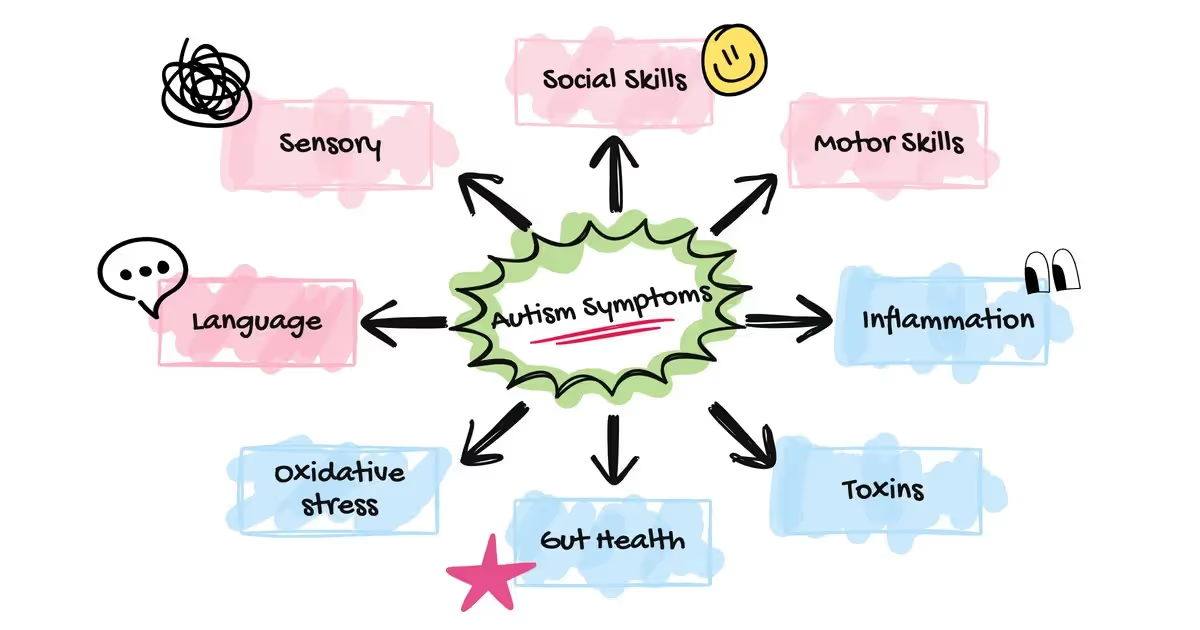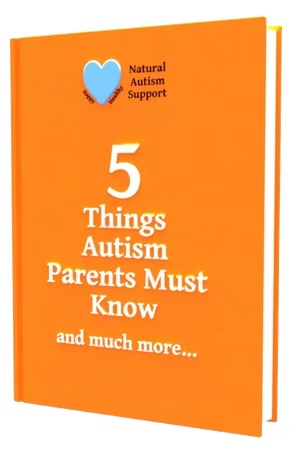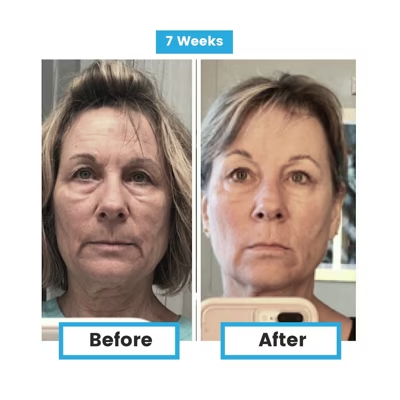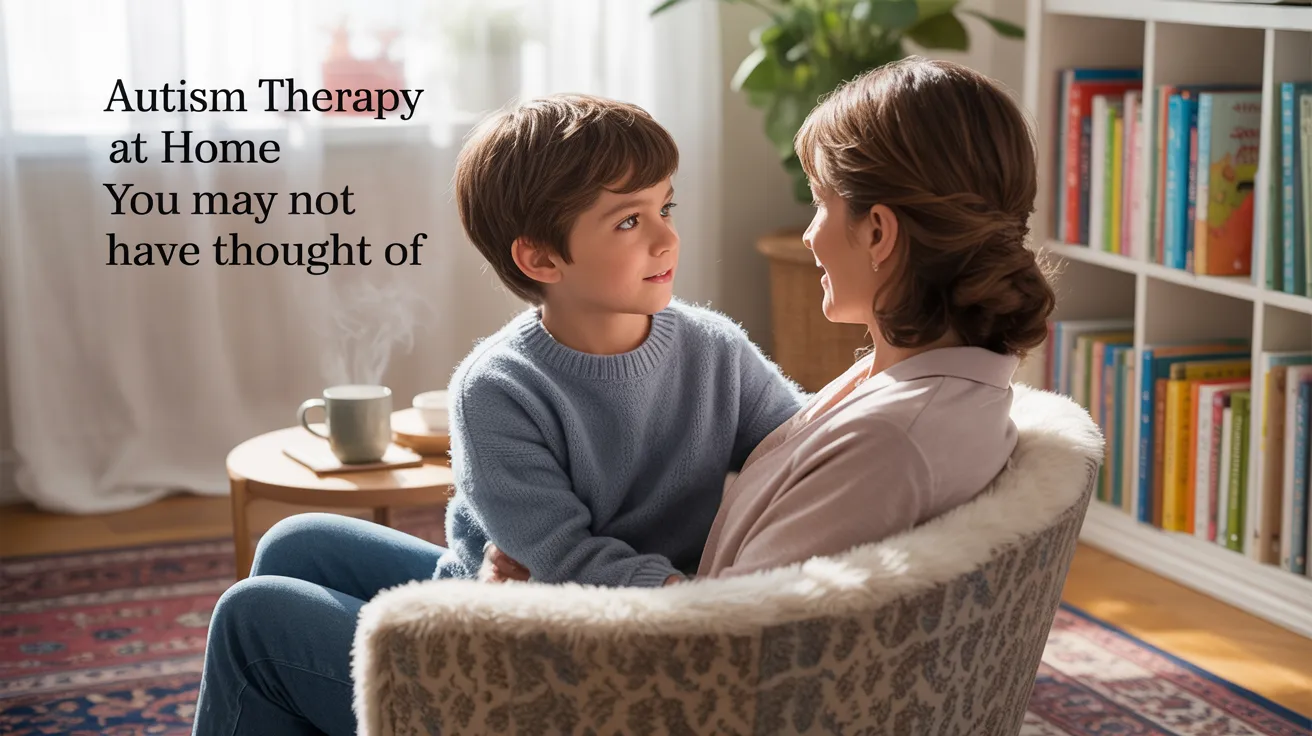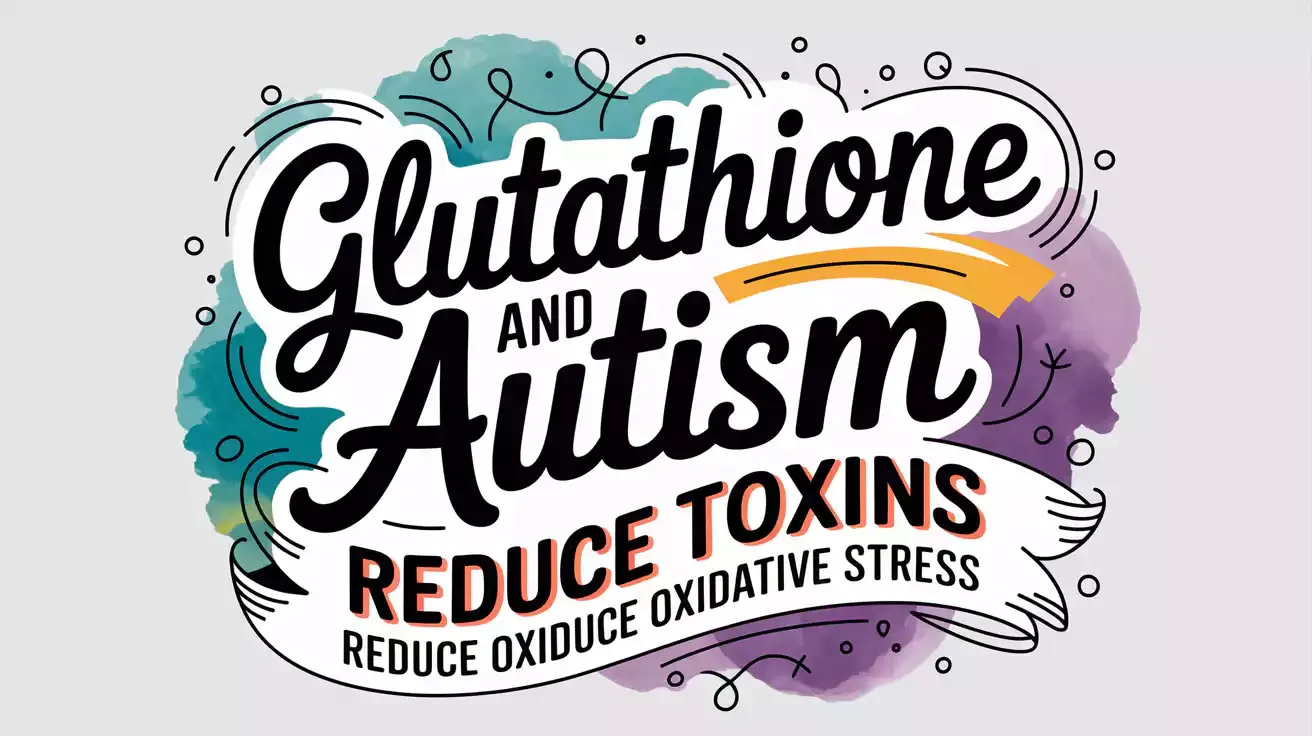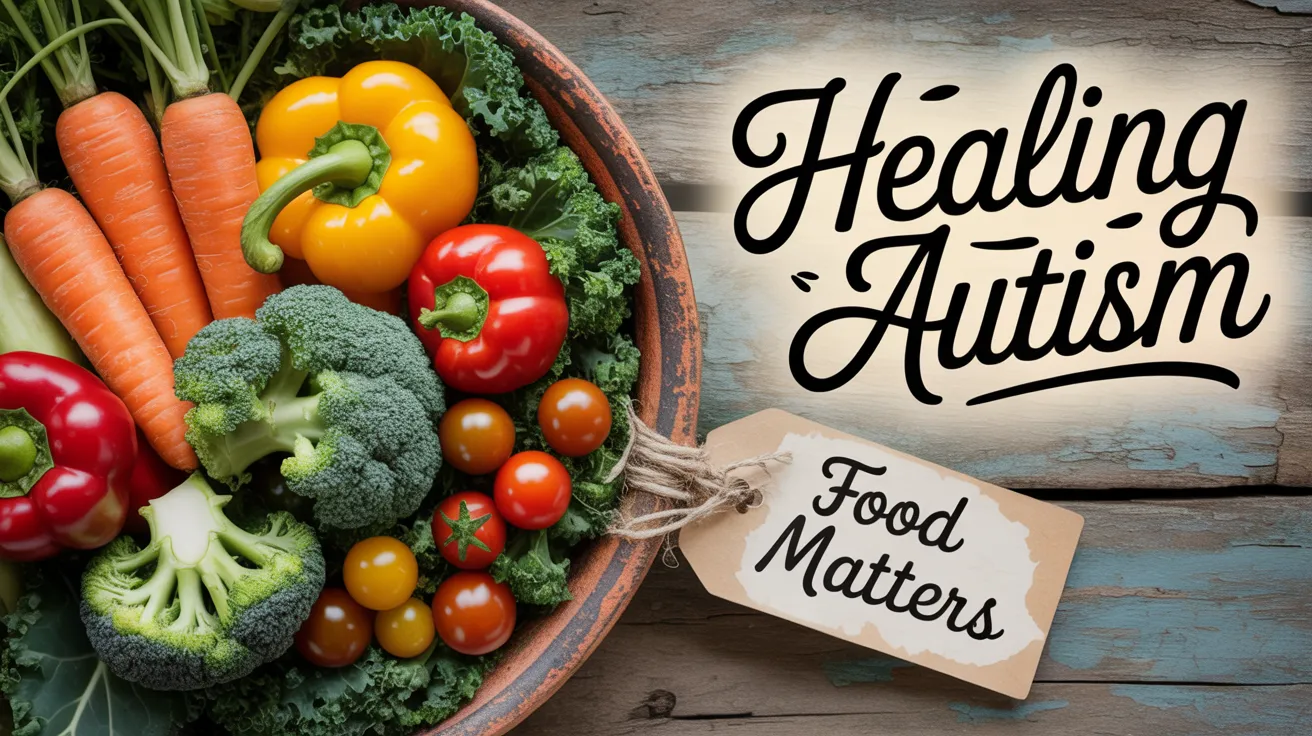In Brief
Autism is a spectrum of symptoms, predominantly defined by delays in social skills, communication skills, and repetitive behaviours. Definitions are fine, but sometimes we need a deeper look. Are the symptoms of autism the underlying cause of the condition? Or are the causes of the symptoms what autism really is?
It's wise to explore autism screening if you have any concerns for your child.
What Is Autism? - The Official Summary
Autism, or autism spectrum disorder (ASD), refers to a broad range of conditions characterised by difficulties with social skills, communication, relationships, and self-regulation.
Autism is typically thought of as a lifelong developmental disability that presents itself in early childhood. Children with autism often have difficulty understanding the world around them, relating to people around them and managing their emotions. Additionally, they often have repetitive behaviours and restricted interests as a result of the condition.
Children with autism usually have difficulty relating to people and understanding the world around them. They tend to have repetitive behaviours and restricted interests. Some children with autism may experience unusual sensory perceptions, such as hypersensitivity to certain sounds, textures, tastes, smells, and sights.
Worried caregivers should know that they are not alone. Many others face similar feelings of uncertainty when diagnosing and caring for someone with autism. There are more people that have walked the same path than you realise, many of which have had great success with improving the lives of their children.
There are different types of autism spectrum disorders (ASDs), including;
Asperger syndrome – A mild form of ASD characterised by difficulties with social interaction but not by restricted interests, behaviours, or activities.
Autistic disorder – A more severe form of ASD characterised by significant impairment in social interaction and communication, as well as restrictive and/or repetitive behaviours and interests.
Pervasive Developmental Disorder Not Otherwise Specified – A less severe form of ASD characterised by persistent deficits in reciprocal social interactions and communication.
A report in 2020 from the Centers for Disease Control (CDC) in the USA concluded that the rate of ASD diagnosis is 1 in every 44 children. This rate has grown quite quickly from the reported 1 in 125 from 2004.
If you're a parent of a child with autism, like me, you'll probably want a better answer. The answer to the questions - what is autism? - is usually given as a number of symptoms and traits. In reality, autism symptoms aren't autism. Autism is something else which causes the symptoms. So lets look at autism from another angle.
What Is Autism? - From Another Angle
We parents have a variety of views on autism. Autism is a label for children based on their traits and behaviors, similar to calling someone 'athletic' for being good at sports. Autism is not a diagnosis in the same order as a diagnosis of cancer, for example, which involves diagnostic pathology and imaging. The diagnosis of Autism uses no such tools.
Psychologists say our child has a developmental disorder because their brain is wired differently. However, no tests have been conducted to confirm this diagnosis. The logic used by the psychologists flows something like this.
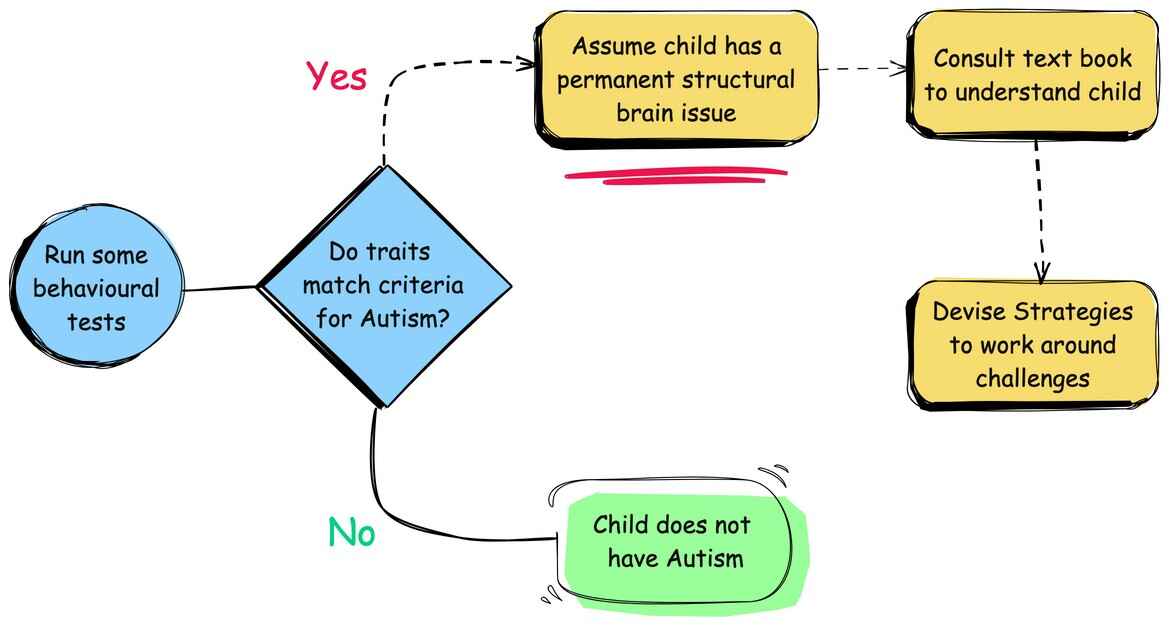
Unfortunately, assumptions can get in the way of the truth. We parents don't want to risk going down the wrong path as a result of assumptions that may not be true.
Our kids deserve better!
Autism can be used as a term to help us explain to others and get extra assistance where needed. Without the term 'autism' it would be difficult when explaining the challenges of our child to others. We would spend a few minutes describing our child, in which time, the average modern person in the smartphone generation would switch off and start scrolling through their social network feed.
In reality, our kids are not autistic. They may be simply having some challenges with certain parts of their development. In many cases, the differences aren't challenges, they are just differences and in some cases enhancements!
To help our children become their best selves, we should support them in overcoming their challenges. However, we should also avoid considering symptoms of Autism as problems.People are meant to be individuals.
The help our children, we need to be open to a wider range of strategies. The remainder of this post will cover some key aspects of Autism, but from an alternative point of view.
The further enhance your ability to help your child on the spectrum, seek parents that have walked the path already. For further support, you can join our online private community with parents of kids in the spectrum and learn about the benefits of hiring an autism life coach.
Signs And Symptoms Of Autism Spectrum Disorder (ASD)
Signs and symptoms of Autism can help us as parents and medical professionals to focus our efforts to help children with autism. In some settings, there can be a focus from people to use the signs and symptoms to diagnose a child as either autistic or not, then further categorise them to represent where on the spectrum they belong. A better use of the signs and symptoms is to use them to guide our focus and help our children.
Signs that need to be addressed first include those that negatively impact people's life. Some of these include:
Inability to comfortably engage in eye contact.
Visual and auditory sensory challenges.
Difficulty with speech.
Impaired motor skills.
Difficulty understanding language.
Poor social skills.
In the list above, I have intentionally not mentioned those signs of autism that involve things such as different interests and the way children play. Having different interests and some behaviours can be good, but clinicians may view them negatively because they set the child apart from what is considered typical.
I have added poor social skills to the list above because sometimes there needs to be a focus on helping children socially as they come out of the autism fog to enhance their life. Children that have been overwhelmed with the symptoms of autism may not have had the opportunity to develop social skills and connection in the normal timeline. Therefore, they may want and need additional support in this area.
There are other symptoms of autism that are often overlooked. This includes a range of issues, including gastrointestinal problems and persistent toe-walking. These symptoms aren't considered to be autism traits, but they are more common in children diagnosed on the autism spectrum than those that aren't. If you're child has gut issues such s diarrhoea or constipation, please read the post - Gut Health and Autism.
In my view, the signs of autism above all have a common influencing factor of poor gut and mitochondria health. Issues with gut and mitochondria result in increased inflammation, as confirmed in studies comparing kids on the spectrum with neurotypical children. Studies comparing children on the spectrum to neurotypical children regularly show autistic children have increases in inflammation and oxidative stress. The increases in inflammation tend to be found in the nervous system and the brain, which I believe is a major factor in the signs of autism mentioned above.
Based on the evidence of increases in nervous system inflammation in groups of children with ASD, it makes sense to improve their health and implement strategies to reduce inflammation. As many parents and doctors can attest to, strategies addressing inflammation, gut health and mitochondria health can have amazing results.
For a more comprehensive and broader view of autism symptoms, including the ones that most have, but experts ignore, visit the post - Understanding ASD - Autism Symptoms: A Holistic Perspective.
What Causes Autism?
Autism is a spectrum of disorders with a spectrum of possible causes. Due to it's complexity, the common path for intervention with autism doesn't spend much time on uncovering the cause of autism. The diagnosis is made, permanent brain development issue from birth is assumed and potentially contributing factors are not explored any further.
As described above, an often overlooked cause of autism may be gut and mitochondria health issues and the resultant inflammation and impaired energy production. If we had access to an unlimited supply of information for each child, we would probably find many contributing factors rather than a single cause. If you are able to find and afford a skilled integrative medicine practitioner, you would likely uncover many of these factors.
What Are Some Of The Best Natural Treatments For Autism?
There is a well established treatment pathway for autism that involves early intervention therapies. These therapies are important and can significantly help children on the spectrum. These therapies, including psychology, speech pathology and occupational therapy will be the backbone of your child's treatment plan. You are probably already utilising these therapies, so I won't go into much detail on those treatments in this post. The purpose of this post is to offer some additional approaches and understanding.
Most of us don't have access to or have the funds to utilise a skilled integrative health practitioner right from the start. As such, we need to make some improvements to health and lifestyle first. An integrative health practitioner will suggest you do this anyway, so why not start now.
The health and lifestyle changes that I mention here are not to be considered medical advice and are my opinion only. You should seek advice from a qualified health professional able to provide specific advice The ideas below are general only.
Consider start with changes to the diet that remove potentially inflammatory foods. Consider implementing an elimination diet protocol that works for you. You can find many good options from simple internet searches and books. Elimination diets remove likely foods that are causing inflammation, then reintroduce them one-by-one and monitor symptoms.
Common inflammatory foods includes:
Gluten
Dairy, especially milk.
Eggs
Sugar
Our son had noticeable improvements in his wellbeing and symptoms quite quickly from eliminating milk and gluten. This gave us incredible hope and motivation to continue. We knew that we were on the right track.
Increase the amount of vegetables in the diet while reducing processed foods. Focus on nutrient dense foods.
Our default these days is to make sure we are filling our kids up with food. We believe that we need to provide enough energy for our children to grow and thrive, so we want to fill them up. I urge you to stop thinking like that! Please focus on quality food. That's where health comes from.
If you are ready for some fine-tuning and potential supplements, that's where you should seek help from a good integrative health practitioner who can run diagnostic tests and specific advice.
For more details on various therapies available to help your child, including alternative strategies, please visit our post about autism therapy at home. There are many additional strategies and therapies that can be very helpful that you may not have explored yet, such as those to help with noise sensitivities and primitive reflexes.
Frequently Asked Questions
Why is it called the 'autism spectrum'?
The term 'spectrum' is really important because it highlights the incredible diversity within autism. Think of a rainbow: it has many different colors, but they all blend into one another. Similarly, autism isn't a single condition with one set of symptoms; instead, it's a range of characteristics that can present differently in each person.
When we say 'spectrum,' we mean there's variation in several key areas:
- Severity of characteristics: Some individuals might have characteristics that significantly impact their daily life, while others might have more subtle traits.
- Areas of impact: One person might primarily experience challenges with social communication, while another might have more prominent sensory sensitivities or repetitive behaviors.
- Co-occurring conditions: Autism often co-occurs with other conditions like ADHD, anxiety, or learning differences, further adding to the individual's unique profile.
- Support needs: The level of support an autistic person needs can vary widely, from minimal to significant assistance in daily living.
This wide range is why you'll often hear the phrase, 'If you've met one autistic person, you've met one autistic person' – emphasizing that each individual's experience is unique!
How might autism affect someone's daily life or interactions?
Autism affects each person uniquely, but there are common areas where differences might be observed in daily life and interactions. It's important to remember these are variations in how brains process information, not deficits in character or intelligence.
Some common ways autism might influence daily life include:
- Social Communication: Autistic individuals might interpret social cues (like facial expressions or tone of voice) differently, prefer direct communication over subtle hints, or find eye contact uncomfortable. They may struggle with small talk but thrive in discussions about their special interests.
- Sensory Processing: Everyday sounds, lights, textures, or smells that most people barely notice can be overwhelming or even painful for an autistic person. Conversely, some might seek out more sensory input. This can make crowded places, bright lights, or certain clothing very challenging.
- Routines and Predictability: Many autistic people find comfort and safety in routines and predictability. Unexpected changes can be highly distressing and lead to anxiety or meltdowns (an intense, involuntary response to overwhelm).
- Special Interests: A common and often delightful aspect of autism is having intense, focused interests. While sometimes seen as 'restricted,' these can be a source of great joy, learning, and connection, leading to deep knowledge and expertise.
- Emotional Regulation: Autistic individuals might experience emotions very intensely, and difficulty in processing external stimuli can sometimes lead to overwhelm, expressed through shutdowns (withdrawing) or meltdowns (outbursts).
Understanding these potential differences helps us create more inclusive and comfortable environments for everyone.
What are some common strengths associated with autism, and how can we be more supportive and inclusive?
While autism presents challenges, it's crucial to recognize and celebrate the many unique strengths and perspectives that autistic individuals bring to our world. Embracing these strengths is key to true inclusion.
Some common strengths include:
- Exceptional Attention to Detail: Many autistic people notice details others miss, leading to thoroughness and precision in tasks.
- Strong Logical Reasoning: A tendency to think systematically and logically can lead to excellent problem-solving skills.
- Deep Focus and Expertise: Intense special interests can translate into incredible knowledge and passion for specific subjects, making them experts in their chosen fields.
- Honesty and Directness: Autistic individuals often value truthfulness and communicate directly, which can be refreshing and build trust.
- Unique Perspectives: Thinking outside the box is a common trait, leading to innovative ideas and solutions.
- Strong Memory for Facts: Many have an excellent ability to recall information, data, and facts.
To be more supportive and inclusive, we can:
- Educate Ourselves: Learn about autism from autistic voices and reputable sources.
- Practice Clear Communication: Be direct, literal, and avoid sarcasm or complex metaphors. Give time for processing information.
- Respect Sensory Needs: Be mindful of environments. Offer quiet spaces, lower lighting, or earplugs if possible. Understand that 'stimming' (self-stimulatory behaviors like rocking or hand flapping) is often a way to self-regulate and should be respected unless harmful.
- Value Differences: Recognize that different ways of thinking, communicating, and experiencing the world are valid and valuable.
- Provide Predictability: When possible, provide clear expectations and warn about changes to routines.
- Advocate for Accessibility: Support accessible environments and opportunities in education, employment, and social settings.
By shifting our perspective from 'fixing' autism to understanding and accommodating neurodiversity, we create a more welcoming and enriching society for everyone.
How can we address the root causes of autism?
Autism is a spectrum, and its root causes are complex and unique to each individual. There isn’t a single cause—rather, it’s often a combination of genetic predispositions and environmental influences that come together in a perfect storm. Think of it like a puzzle: genetics, immune stressors, gut health, mitochondrial function, toxins, and even chronic infections can all play a role.
Here’s the empowering truth: While we may not always be able to pinpoint every root cause, we can take action to address many contributing factors. Working with a skilled integrative medicine practitioner can help you uncover these factors for your child. Some of the most common areas to explore include:
Gut health and digestion
Mitochondrial function (the energy factories of the cells)
Reducing inflammation and oxidative stress
Supporting detoxification pathways
Addressing nutritional deficiencies
I you would like to explore strategies for addressing the root causes of autism, please root my post that covers ways to heal autism naturally.
Supplements can play a role in supporting detoxification and reducing oxidative stress and inflammation. For example, glutathione is a master antioxidant that many parents have found helpful. You can read more about glutathione and autism here.
Remember, every child is different, and what works for one may not work for another. Always seek professional, personalized medical advice before starting any new therapies or supplements.
